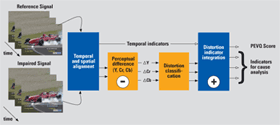|
 |
|
|
OPTICOM, the leading provider of signal based perceptual measurement technology for voice, audio and video, offers its new easy to use
PEVQ V 2.0 measurement as an OEM solution. PEVQ evaluates the quality of CIF, QCIF, VGA and Rec. 601 video formats based on perceptual measurement, reliably, objectively and fast.
PEVQ is based on the earlier PVQM technology developed by KPN Research and new developments of OPTICOM.
|
|
|
|
click to [ enlarge picture ]
|
|
| • |
Analysis of video quality |
| • |
Outputs MOS score that correlates well with subjective MOS
|
| • |
Additional KPIs for detailed analysis |
| • |
Measurement with QCIF (real time), CIF, VGA and Rec. 601 video sizes |
| • |
Perceptually based end-to-end quality analysis |
| • |
Available as DLL/Library or Source |
| • |
Applications: IPTV, streaming video, 3G, video telephony |
 |
|
The algorithm can be divided up into four separate blocks. The first block – pre-processing stage – is responsible for the spatial and temporal alignment of the reference and the impaired signal. This process ensures that only corresponding frames are compared to each other.
The second block calculates the perceptual difference of the aligned signals. Perceptual means that only those differences are taken into account which are actually perceived by a human viewer. Furthermore the activity of the motion in the reference signal provides another indicator representing the temporal information.
This indicator is important as it takes into account that in frame series with low activity the perception of details is much higher than in frame series with quick motion.
The third block in the figure classifies the previously calculated indicators and detects certain types of distortions.
Finally, in the fourth block all the appropriate indicators according to the detected distortions are aggregated, forming the final result - the mean opinion score (MOS). The MOS value describes the video quality on a range from 1 for very bad quality, to 5 for excellent quality.
|
|
|
| Functionality |
• |
Perceptual Evaluation of Video Quality- PEVQ, with mapping to MOS scale (1 bad, … 5 excellent quality) |
|
|
| Input data |
• |
AVI with RGB24, YUV video data |
| |
• |
QCIF, CIF, VGA and Rec. 601 frame sizes
|
| |
• |
6 to 20 seconds in length |
|
|
| Complexity |
• |
V2.0 is widely optimized and is capable of processing QCIF streams faster than realtime on a 3GHz Pentium 4 machine. |
|
|
| Platforms |
• |
Windows |
| |
• |
Linux
(others on request) |
 |
|
PEVQ MOS
The PEVQ MOS value lies within a range from 1 (bad) to 5 (excellent). The PEVQ MOS is based on a multitude of perceptually motivated parameters. |
|
|
|
Distortion indicators
For a more detailed analysis the perceptual level of distortion in the luminance, chrominance and temporal domain are provided. |
|
|
|
Delay
The delay of each frame of the test signal related to the reference signal. |
|
|
|
Brightness
The brightness of the reference and degraded signal. |
|
|
|
Contrast
The contrast of the distorted and the reference sequence. |
|
|
|
PSNR
To allow for a coarse analysis of he distortions in different domains the PSNR is provided for the Y, Cb and Cr components separately. |
|
|
|
Jerkiness
describes the smoothness of a video playback which is often impaired by down-sampling, coding processes and perturbed transmissions. |
|
|
|
Blur
is a distortion characterized by reduced sharpness of contour edges and spatial detail. |
|
|
|
Blockiness
is often the result of a low bit rate coding that uses a block matching algorithm for the motion estimation and a coarse quantization for the image blocks. |
|
|
|
Frame Skips and Freezes
are temporal artefacts occurring in video transmissions caused by e.g. overloaded networks. |
|
|
|
Effective Frame Rate
Down-sampling of a video signal on a frame by frame basis often results in loss of information which often leads to the degradation of the video signal. The effective frame rate is an indicator quantifying the severeness of such a process. |
|
|
|
Temporal and Spacial Activity
Temporal and spacial activity indicators quantify the amount of activity /movement in the video content. These indicators are derived from ITU-T recommendation P.910. |
 |
|
|
|
| > Download more detailed information |
|
|
|
|
|
|
|
|
|
|
[top] |
|
|
|


